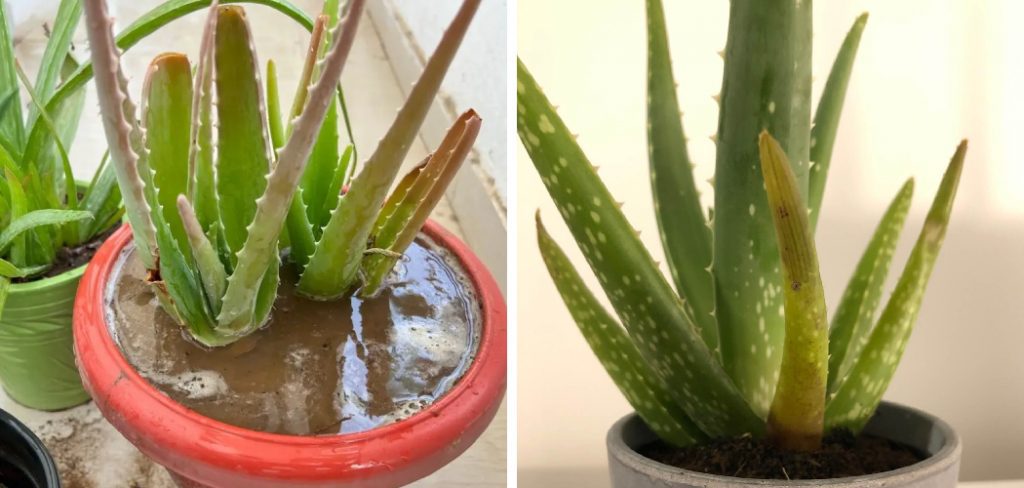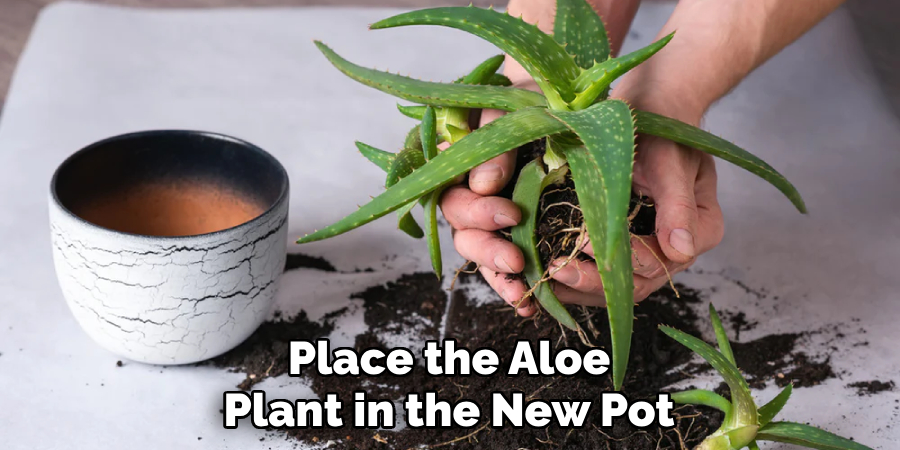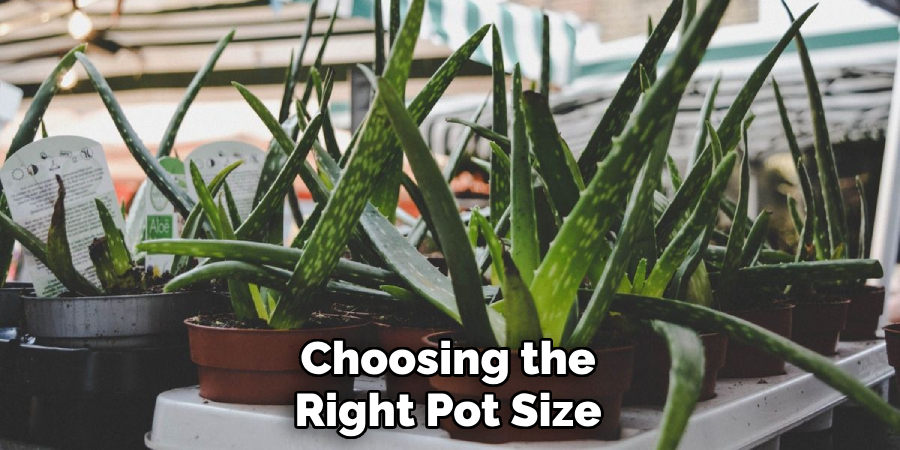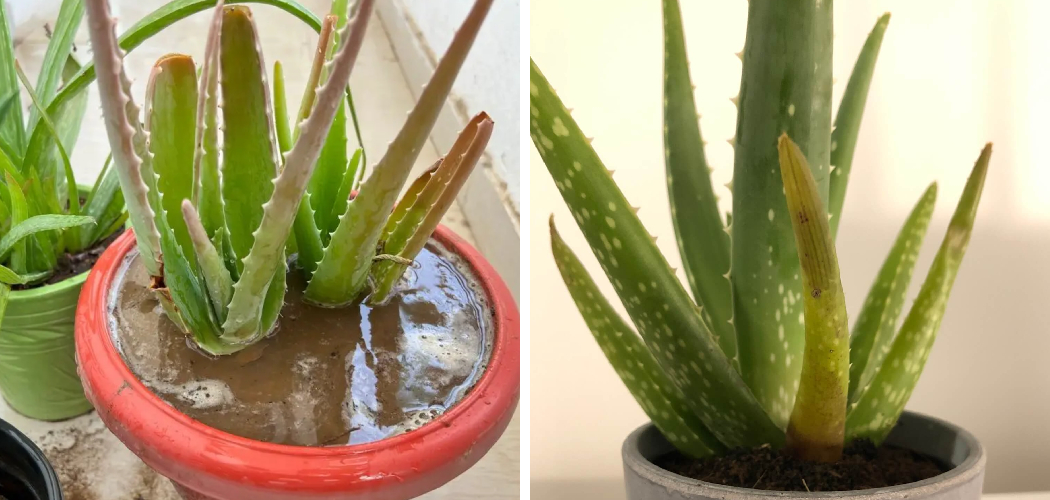To fix an overwatered aloe plant, first ensure proper drainage in the pot and let the soil dry out completely before watering again. Overwatering aloe plants can lead to root rot and other issues, so it’s crucial to address this problem promptly.
If you find your aloe plant looking droopy, discolored, or showing signs of root rot, the chances are that you have been overwatering it. While aloe plants are generally hardy and drought-tolerant, excessive watering can cause serious damage. Overwatering disrupts the plant’s ability to absorb nutrients and oxygen, leading to root suffocation and eventual plant death.
However, by following a few simple steps, you can nurse your overwatered aloe plant back to health. In this guide, we will explore effective techniques to fix an overwatered aloe plant and restore it to its vibrant and thriving state.

Reasons For Overwatering An Aloe Plant
Overwatering an aloe plant can lead to several issues. One reason for overwatering is the lack of proper drainage in the pot. When the water cannot escape, the plant’s roots become waterlogged. Another cause is watering too frequently. Aloe plants prefer drier conditions, so consistently watering them can lead to overwatering.
Lastly, using the wrong potting soil can also contribute to this problem. Soil that retains too much moisture can cause the aloe plant to get watered excessively. To fix an overwatered aloe plant, it is important to address the root cause.
Ensure that the pot has proper drainage, adjust the watering frequency to suit the plant’s needs, and use well-draining soil. Taking these steps will help restore the health of your overwatered aloe plant.
Signs Of Overwatering In Aloe Plants
Overwatering can lead to several signs that indicate your aloe plant is not doing well. Yellowing or wilting leaves are one of the most common indications of overwatering. If your plant’s stem feels mushy or soft when touched, it is a clear sign of excessive watering.
Another sign is root rot, where the roots become brown, slimy, and may emit a foul odor. It is important to address these signs promptly to save your aloe plant. To fix an overwatered aloe plant, you need to adjust your watering schedule and ensure that the soil is well-draining.
Allow the soil to dry out between waterings and consider repotting the plant in a suitable potting mix. By taking these steps, you can revive your overwatered aloe plant and promote healthier growth.
Remedies For Overwatered Aloe Plant
Overwatered aloe plants can be saved by checking for proper drainage. Ensure that the pot has holes for excess water to escape. Adjust the watering frequency to prevent overwatering. Let the soil dry out completely before watering again. If the root ball is waterlogged, repot the aloe plant using well-draining soil.
This will allow for better water absorption and prevent excessive moisture. Be sure to gently remove the plant from the pot and shake off excess soil before replanting. Choose a pot that is slightly larger than the previous one to accommodate growth.
Remember to water sparingly and only when the soil is dry to the touch. By following these remedies, you can revive an overwatered aloe plant and promote its healthy growth.
How to Fix an Overwatered Aloe Plant: Step by Step Guide
Checking For Proper Drainage
Proper drainage is crucial for fixing an overwatered aloe plant. First, assess the current pot and its drainage holes. Ensure they are sufficient for water to escape. If not, consider enhancing drainage by adding pebbles or gravel at the bottom of the pot.
This will create space for excess water to accumulate without saturating the plant’s roots. Additionally, using a well-draining potting mix is vital. It allows water to pass through easily and prevents waterlogged soil. By following these steps, you can help your overwatered aloe plant recover and thrive.
Adjusting Watering Frequency
Adjust the watering frequency of your overwatered aloe plant by understanding its water requirements. Create a watering schedule and use a moisture meter to monitor moisture levels. These steps will help you fix the problem.
Repotting With Well-Draining Soil
To fix an overwatered aloe plant, start by preparing a new pot with well-draining soil. Remove the plant from its current pot, being careful not to damage the roots. Gently shake off excess soil and inspect the roots for any signs of rot or damage.
If necessary, trim away any unhealthy roots. Next, place the aloe plant in the new pot, ensuring it is positioned at the same depth as before. Fill the pot with fresh well-draining soil, gently pressing it down around the plant to provide stability.

Avoid overwatering the plant in the future by allowing the soil to dry completely between waterings. Place the repotted aloe plant in a location with bright, indirect sunlight, and monitor its growth and moisture levels carefully. By following these steps, you can restore your overwatered aloe plant to a healthier state.
Caring For An Aloe Plant To Avoid Overwatering
Caring for an aloe plant to avoid overwatering is crucial. Providing proper sunlight exposure is key. Aloe plants should be placed in an area that receives bright but indirect sunlight. Implementing a balanced watering routine is essential. It’s important to allow the soil to dry out completely between waterings.
Using appropriate pot sizes is also important. Aloe plants prefer slightly snug pots, so choose a pot that is only slightly larger than the root ball. With these guidelines in mind, you can effectively care for your aloe plant and prevent overwatering.
Sunlight Requirements For Aloe Plants
Aloe plants require appropriate sunlight for their growth and health. Understanding their light preferences is essential. When placing your aloe plant, make sure to find the right spot that offers the ideal amount of sunlight. To regulate the exposure, you may opt for curtains or blinds, which can be adjusted as needed.
By doing so, you can prevent your aloe plant from being overexposed to the sun or receiving too little light. Maintaining a balance in sunlight intake will help fix an overwatered aloe plant and promote its revival. Remember, finding the right amount of sunlight is crucial for the overall well-being of your aloe plant.
Implementing A Balanced Watering Routine
Implementing a balanced watering routine is essential to fix an overwatered aloe plant. To begin, it is crucial to understand the water needs of aloe plants. Before watering, test the soil moisture to determine if it is already damp. Using the soak and dry method can help prevent overwatering.
This involves fully saturating the soil and allowing it to dry completely before watering again. By following this routine, you can provide the right amount of water to your aloe plant and avoid overwatering. Remember to monitor the soil moisture regularly and adjust your watering schedule accordingly.
Maintaining a balanced watering routine will ensure the health and vitality of your aloe plant.
Choosing Appropriate Pot Sizes
Choosing the right pot size is crucial for fixing an overwatered aloe plant. Understanding the relationship between pot size and water retention is the key. As your aloe plant grows, consider transplanting it to a larger pot. This allows for better drainage and prevents waterlogging.

Monitor the plant’s condition and adjust pot sizes accordingly to ensure proper water absorption. By keeping a close eye on the pot size and water retention, you can successfully fix an overwatered aloe plant. Remember, the size of the pot plays a significant role in maintaining the plant’s health.
So, make sure to choose an appropriate pot size to avoid overwatering in the first place.
Frequently Asked Questions Of How To Fix An Overwatered Aloe Plant
How Do You Know If Your Aloe Plant Is Overwatered?
Overwatered aloe plants may have soggy leaves, yellowing or browning leaves, and a foul odor. The soil will feel excessively wet and the plant may wilt or become mushy.
Can An Overwatered Aloe Plant Be Saved?
Yes, an overwatered aloe plant can be saved. Start by stopping watering immediately and allowing the soil to dry out. Trim any rotting or dead parts of the plant and repot it in well-draining soil. Gradually resume watering once the soil is completely dry.
How Often Should You Water An Aloe Plant?
Aloe plants should be watered sparingly. Water the plant thoroughly and deeply once every 2-3 weeks, allowing the soil to completely dry out between waterings. Overwatering can lead to root rot and other issues.
Why Is My Aloe Plant Turning Brown?
Brown leaves on an aloe plant can be a sign of overwatering, sunburn, or pests. Evaluate the watering schedule, ensure the plant is not receiving too much direct sunlight, and check for any signs of insects or mites.
How Can I Prevent My Aloe Plant From Becoming Overwatered?
To prevent overwatering, make sure the pot has good drainage holes and use well-draining soil. Allow the soil to dry out completely before watering again. Avoid watering on a strict schedule and instead base watering on the plant’s needs.
Conclusion
Fixing an overwatered aloe plant requires a delicate balance of attentive care and patience. Through proper watering techniques and providing adequate drainage, you can save your aloe plant from the perils of excess moisture. Remember to assess the soil moisture levels before giving any more water, allowing the topsoil to dry out before irrigating again.
Repotting the plant in well-draining soil can also facilitate the recovery process. Additionally, ensuring proper sunlight and temperature conditions will promote healthy growth and healing. Regularly monitoring the health of your aloe plant and taking corrective actions promptly will help prevent overwatering issues in the future.
By following these simple steps, your aloe plant can thrive and continue to provide you with its soothing and beneficial properties for years to come. So go ahead, give your plant the care it deserves and enjoy the beauty and benefits of a healthy aloe plant.

